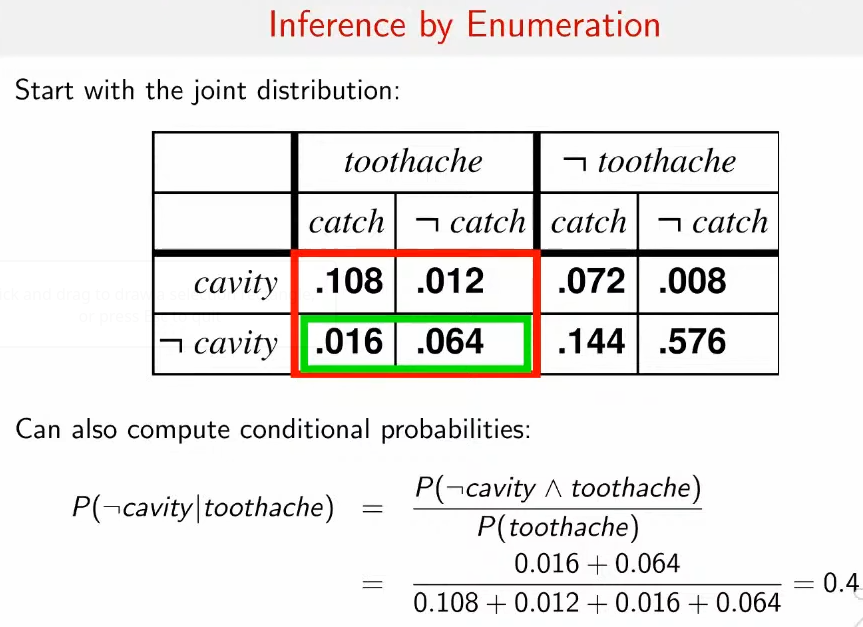04 - Probability in ML
Overview
- Description:: revising general probability concepts
Revising
- we want to learn a function f: X → Y
- we have a dataset D = {(…)}
- we have a hypotesis space H where we want to search the best possible value
Probability
- we model probability of an action to determine what’s the best choice
- this is done because we hate to take decisions that are not suitable for our cases
- ex. how much time should we leave before departing from a place in the airport
Elements of probability
Probability space
- is a sample point / possible word / outcome of a random process…
A probability space (or probability model) is a function such that
- 0 ⇐ P(w) ⇐ 1
- P() = 1
Example: rolling a die An event is any subset of Probability of an event A is a function assigning to A a value in [0,1]
examples:
- A1 = “die roll < 4”: A1 =
- P(A1) = P(1) + P(2) + P(3) = 1/6 + 1/6 + 1/6 = 1/2
- (they are all indipendent events!. Obviously a single dice roll could result in just one of those probabilities, therefore is + not *)
Random variable
A random variable is a function that maps sample space to some range (the reals, or Booleans…)
Example:
X is a variable and a function!
X = the random variable X has the value X = is like saying
Example: Odd = true → {1,3,5}
We can compute the probability of a random variable, by summing all the possible values belonging to the subset.
In the odd example is 1/2 because 1/6+1/6+1/6
Propositions
We can use logical operations to create propositions, using ^, V, not
We assume any event in a proposition is positive, therefore true, unless we use the NOT operator.
We have three operators:
- is *
- V is +
- is - (it means false)
Distributions
Probability distribution is a function assigning to a probability value to all possible assignments of a random variable.
Important
Sum of all values MUST BE 1
Join probability distribution: given two dices (fair), what’s the odd to get 3 on the first and 3 on the second? The first is 1/6, the second is 1/6, they are all separate events, so I just need to multiply each other probability, therefore the answer is 1/36
Also known as In ML I create a table rxc, row x columns, and write down all possible probabilities. The sum of each row and each column must be 1.
Conditional probability
A measure of the probability of an event happening, given that another event has already occurred
The formula is:
In the ML example
The meaning of the formula is “what’s the probability of A KNOWING that B has happened?”
Total probabilities
Chain rule
Example: Card Drawing Game
Suppose you have a standard deck of 52 playing cards. You draw three cards one by one without replacement. Let’s define the events:
- Event A: The first card drawn is a heart.
- Event B: The second card drawn is a face card (jack, queen, or king).
- Event C: The third card drawn is red.
Using the chain rule, the probability of these three events happening in sequence is calculated as follows:
-
Probability of Event A (Drawing a Heart): There are 13 hearts in a deck of 52 cards, so
-
Probability of Event B Given A (Drawing a Face Card Given the First is a Heart): After drawing a heart, there are 12 face cards left in a deck of 51 cards, so
-
Probability of Event C Given A and B (Drawing a Red Card Given the First Two Conditions are Met): After drawing a heart and a face card, there are 24 red cards left in a deck of 50 cards, so
Now, applying the chain rule:
So, the probability that the first card is a heart, the second card is a face card given that the first card is a heart, and the third card is red given the first two conditions is ( ) or approximately ( 0.0282 ) (or ( 2.82% ).
Inference by enumeration

Conditional indipendence
- like the distributive law
Product rule and Bayes
⇒ from here we derive Bayes Rule
in distribution form
Useful for assessing diagnostic probability from causal probability.
This is a typical ML problem!